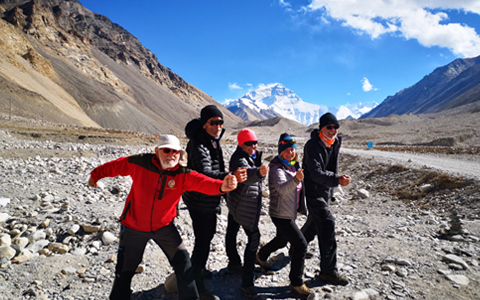In a remote region of Tibet the sacred Mount Kailash towers over the surrounding landscape. At 6,638 meters, the revered mountain holds a place in the spiritual beliefs of Buddhists, Hindus, and followers of the Jain and Bon religions. Despite the attention, Mount Kailash is still a mystery. The unconquered peak remains wrapped in myths, legends, and spiritual tales. Here are 15 unsolved secrets of Mount Kailash that will amaze you.
1. Mount Kailash is Shaped Like a Man-made Pyramid.
Mount Kailash has a distinctive and surprisingly symmetrical shape that has made it a source of wonder since ancient times. Its four triangular faces that rise sharply to a pointed summit look amazingly like the man-made pyramids in Egypt, Central America, and other parts of the world.
The prominent ridges and symmetrical structure add to its pyramid-esque appearance. But, it's important to note that it was formed by natural processes. The unique shape makes for an unmistakable silhouette against the surrounding landscape and continues to add to the mountain's enigmatic aura.
2. Mount Kailash is Said to be the Abode of Lord Shiva.
One of the legends about Mount Kailash, according to Hindu belief, is that it is the home of Lord Shiva. Lord Shiva is one of the principal deities in Hinduism. He is the god of destruction and transformation, as well as the god of meditation and asceticism.
According to legend, Mount Kailash is his divine residence. Lord Shiva is said to reside there with his consort, the Goddess Parvati. Hindu legend tells that he sits atop the sacred mountain, meditating in perpetual stillness surrounded by divine energies. Hindu pilgrims do the Kailash Mansarovar Yatra to seek blessings and enlightenment by paying homage to the abode of Lord Shiva.
 According to Hindu belief, Mount Kailash is the home of Lord Shiva.
According to Hindu belief, Mount Kailash is the home of Lord Shiva.3. Mount Kailash is a Sacred Mountain in Four Religions.
In addition to Hinduism, Mount Kailash is revered in the beliefs of three other religions.
Buddhism: In Tibetan Buddhist traditions, Mount Kailash is known as Kang Rinpoche or Gang Rinpoche. They believe the deities Chakrasamvara and Demchog dwell in the mountain. The Tibetan saint Milarepa is also associated with Mount Kailash. He is believed to have meditated in the caves surrounding the mountain.
Jainism: Mount Kailash is mentioned in the Jain scriptures as the place where the founder of Jainism, Lord Rishabhadeva, attained liberation. The mountain is known as Ashtapada.
 Mount Kailash is revered by four religions.
Mount Kailash is revered by four religions.Bon Faith: The Bon religion is the ancient spiritual tradition of Tibet that pre-dates Buddhism in the region. Followers of the Bon religion consider Mount Kailash to be the spiritual center of their faith, and it is the site of many rituals and ceremonies.
4. Climbing to the Peak of Mount Kailash is Impossible.
The 6,638-meter Mount Kailash is one of the few unconquered and unclimbable mountains in the world. One reason is the challenging terrain. Mount Kailash has steep, icy slopes in extremely rugged surroundings. Harsh and often unpredictable weather much of the year would make it a very challenging mountain to climb.
More importantly, the religious significance of Mount Kailash as a sacred site stops people from climbing it. In the Buddhist, Hindu, Jain, and Bon faiths, climbing the mountain is forbidden. Respect for local beliefs discourages any attempts.
5. Mount Kailash is Considered the Center of the World.
Part of the spiritual traditions involving Mount Kailash is that it is revered as the cosmic axis or center of the world. Often referred to as the "naval of the universe" in Tibetan Buddhist mythologies, it is the dwelling place of important deities and a sanctuary where the world was born.
 Pilgrims do the kora around the Mount Kailash.
Pilgrims do the kora around the Mount Kailash.It is the pivotal location in Jainism as the place where their founder attained liberation and is known as the cosmic axis in the Bon faith. Pilgrimage to circumambulate the mountain brings spiritual purification and liberation from the cycle of existence.
6. It's Believed that Mount Kailash Connects Earth to Heaven.
It is a common theme in religions that hold the mountain sacred that Mount Kailash is the place that acts as a bridge between heaven and Earth. Tibetan Buddhists see it as a gateway to spiritual realms and a focal point for meditation and pilgrimage. In Hindu mythology, it is the junction where the physical and metaphysical worlds meet. This symbolism makes the mountain an important place for spiritual energies, enlightenment, and transcendence.
7. The Snow on Mount Kailash Never Melts.
The legends and mystical stories surrounding Mount Kailash tell us that the mountain's snowcap never melts. Mount Kailash is subject to harsh climate conditions with extremely cold temperatures much of the year. However, the seasonal thaw that comes during the summer months leaves the snowcap untouched. While the snow on the rest of the mountain melts, feeding the rivers that flow from its slopes, the white peak remains a perpetual symbol of purity and spiritual resonance.
 One can always see the snow-capped peak of Mount Kailash.
One can always see the snow-capped peak of Mount Kailash.8. The Smiling Face of Lord Shiva Can be Seen on Mount Kailash.
Legends and personal accounts going back centuries tell of people seeing the smiling face of Lord Shiva on the mountain. The dramatic sight is revealed in the shadows while undertaking a pilgrimage, circumambulating Mount Kailash. The Kailash Mansarovar Yatra follows a clockwise route, and each step reveals new facets of the steep slopes. Each time a new side of the mountain is presented, the face of Lord Shiva may appear, but it is often sighted on the south face.
 The face of Lord Shiva can be presented on Mount Kailash sometimes.
The face of Lord Shiva can be presented on Mount Kailash sometimes.9. Mount Kailash is the Source of 4 Major Asian Rivers.
Mount Kailash is the source of the vital lifeblood of the region. Four major rivers in Asia trace their origin to the mountain and serve an essential role in the lives and culture of millions of people.
Indus River: The Indus River originates around Mount Kailash and flows northwest through Tibet before entering India and eventually traversing Pakistan.
Sutlej River: It also follows a northwest route through Tibet, then flows into the Indian state of Himachal Pradesh before continuing through Punjab. From there, it eventually joins the Indus River in Pakistan.
Brahmaputra River: This river begins as the Yarlung Tsanpo in Tibet, where it flows east. It enters India and follows a course through Assam before flowing into the Bay of Bengal.
Karnali River: The Karnali River is a major tributary of the Ganges. It begins its course flowing south through Nepal before joining the Ganges River in India.
10. There are Good and Evil Lakes Surrounding Mount Kailash.
Two significant lakes are near Mount Kailash with contrasting spiritual significance. Lake Manasarovar is one of the highest freshwater lakes in the world and a place of great spiritual importance. Pilgrims travel to the lake to take a dip in its purifying waters, and it is believed to be of divine origin.
 The Lake Manasarovar is just near to Mount Kailash.
The Lake Manasarovar is just near to Mount Kailash.Lake Rakshastal is the opposite. The lake is considered unholy and is associated with negative forces. Its name comes from a word meaning demon in Hindu mythology. Pilgrims undertaking a Kailash Mansarovar Yatra avoid Lake Rakshastal.
11. It Is Said Time Travels Faster in the Mount Kailash Region.
Adding to the enigmatic aura of Mount Kailash are stories from pilgrims that tell us that time passes faster in the region. People who have participated in the Kailash Mansarovar Yatra report their hair and nails having shown weeks' worth of growth after only a day has gone by. Others report a sense of timelessness while in the vicinity of the mountain. Some claim it is due to the influence of the mountain air. Still, the same experiences don't happen around other mountains in the Himalayas.
12. There are Formations of Swastika And Om Parvat on Mount Kailash during Sunset.
Sunset at Mount Kailash brings the sighting of sacred symbols in the mountain's rock formations. The swastika, a symbol of good fortune in various cultures, reveals itself in the shadows passing over the rugged rock faces. Similarly, Om-shaped natural formations appear in the right lighting. The Om symbol appearing on the mountain adds to its spiritual significance as a place of divine grace.
 Beautiful sunset view of Mount Kailash
Beautiful sunset view of Mount Kailash13. There are Underground Cities in the Kailash Range Area.
Shambhala and Agartha are legendary places believed to be located underground in the Kailash range area. Shambhala is a mythical kingdom believed to be a place of peace and enlightenment. Agartha is a legendary underground realm. It is a hidden civilization existing below the Earth's surface with advanced spiritual knowledge. Stories of their existence in the region have persisted in the local cultural narratives.
14. Mount Kailash Kora is a Lifetime Experience that Can Purify the Soul.
Doing a Mount Kailash Kora is a significant physical and spiritual undertaking and an experience of a lifetime. Pilgrims find it a transformative journey, one that purifies the soul. The approximately 52 km clockwise trek around the mountain goes through rugged terrain and over high-altitude passes. It is a test of physical endurance and spiritual commitment. The challenging conditions, awe-inspiring landscape, and spiritual significance can lead to inner transformation, self-discovery, and a deeper connection with nature or the divine. Everyone is welcome to take on the kora, and it is a journey no one ever forgets.
15. It is Said That Supernatural Energy Created Mount Kailash.
A place of such significance has many legends about how the mountain was created. In Hindu beliefs, Mount Kailash was created by divine forces as part of the cosmic plan to provide a celestial home for Lord Shiva. Other folklore talks of mythical creatures, such as dragons, shaping the landscape and bestowing the mountain with spiritual essence.
Conclusion
The mystery and legends surrounding Mount Kailash continue to add to its allure. Its place in the world as the focus of several different religions combined with its remote location make it a truly unique place to visit. The best way to try and understand the secrets of Mount Kailash is close up on a trekking tour around the mountain and the surrounding region. Then, you can see how it remains a place of spiritual importance for so many people.


























 According to Hindu belief, Mount Kailash is the home of Lord Shiva.
According to Hindu belief, Mount Kailash is the home of Lord Shiva. Mount Kailash is revered by four religions.
Mount Kailash is revered by four religions. Pilgrims do the kora around the Mount Kailash.
Pilgrims do the kora around the Mount Kailash. One can always see the snow-capped peak of Mount Kailash.
One can always see the snow-capped peak of Mount Kailash. The face of Lord Shiva can be presented on Mount Kailash sometimes.
The face of Lord Shiva can be presented on Mount Kailash sometimes. The Lake Manasarovar is just near to Mount Kailash.
The Lake Manasarovar is just near to Mount Kailash. Beautiful sunset view of Mount Kailash
Beautiful sunset view of Mount Kailash















Ask a Quick Question